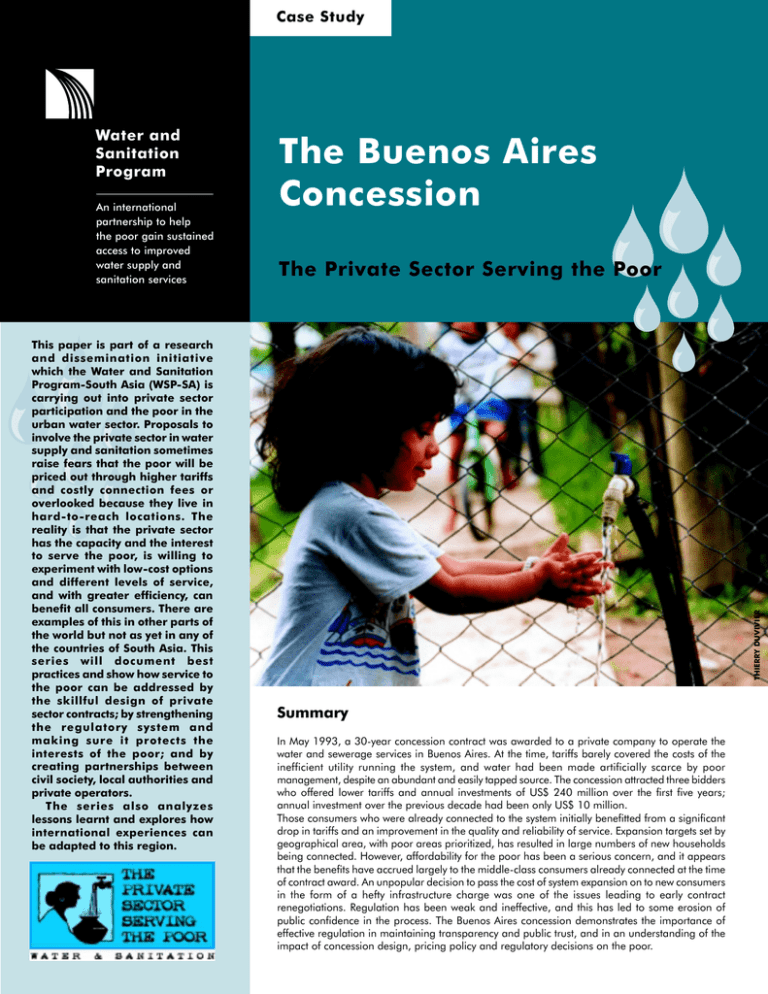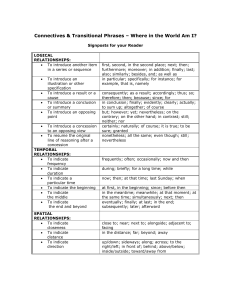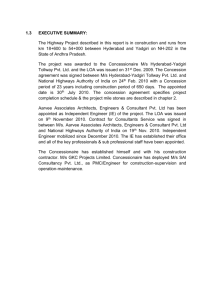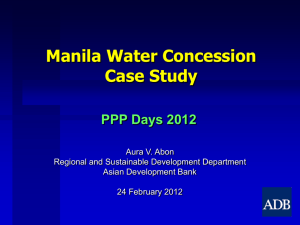The Buenos Aires Concession
advertisement

Case Study An international partnership to help the poor gain sustained access to improved water supply and sanitation services This paper is part of a research and dissemination initiative which the Water and Sanitation Program-South Asia (WSP-SA) is carrying out into private sector participation and the poor in the urban water sector. Proposals to involve the private sector in water supply and sanitation sometimes raise fears that the poor will be priced out through higher tariffs and costly connection fees or overlooked because they live in hard-to-reach locations. The reality is that the private sector has the capacity and the interest to serve the poor, is willing to experiment with low-cost options and different levels of service, and with greater efficiency, can benefit all consumers. There are examples of this in other parts of the world but not as yet in any of the countries of South Asia. This series will document best practices and show how service to the poor can be addressed by the skillful design of private sector contracts; by strengthening the regulatory system and making sure it protects the interests of the poor; and by creating partnerships between civil society, local authorities and private operators. The series also analyzes lessons learnt and explores how international experiences can be adapted to this region. The Buenos Aires Concession The Private Sector Serving the Poor THIERRY DUVIVIER Water and Sanitation Program Summary In May 1993, a 30-year concession contract was awarded to a private company to operate the water and sewerage services in Buenos Aires. At the time, tariffs barely covered the costs of the inefficient utility running the system, and water had been made artificially scarce by poor management, despite an abundant and easily tapped source. The concession attracted three bidders who offered lower tariffs and annual investments of US$ 240 million over the first five years; annual investment over the previous decade had been only US$ 10 million. Those consumers who were already connected to the system initially benefitted from a significant drop in tariffs and an improvement in the quality and reliability of service. Expansion targets set by geographical area, with poor areas prioritized, has resulted in large numbers of new households being connected. However, affordability for the poor has been a serious concern, and it appears that the benefits have accrued largely to the middle-class consumers already connected at the time of contract award. An unpopular decision to pass the cost of system expansion on to new consumers in the form of a hefty infrastructure charge was one of the issues leading to early contract renegotiations. Regulation has been weak and ineffective, and this has led to some erosion of public confidence in the process. The Buenos Aires concession demonstrates the importance of effective regulation in maintaining transparency and public trust, and in an understanding of the impact of concession design, pricing policy and regulatory decisions on the poor. Historical and Political Background In 1989 Argentina was on the verge of bankruptcy, with a rapidly deteriorating economy and spiraling hyperinflation. The newly elected government of Carlos Menem was able to take advantage of a rare political consensus on the need for reform and to introduce wide ranging economic measures, including the restructuring and privatization of inefficient public utilities, of which the water industry was one. In December 1992 a 30-year concession contract for water and sanitation provision in the Buenos Aires metropolitan area was awarded to a private sector consortium who assumed responsibility for operations in May 1993; it remains the largest concession in the world given to a single operator. Buenos Aires is situated beside the Rio de la Plata and has an easily tapped, ample supply of relatively clean raw water. Despite this, the state-owned water utility, OSN (Obras Sanitarias de la Nacion) was providing limited and poor quality service and, with very low levels of investment, was unable to expand connections to the rapidly growing, poorer, areas of the city. Revenues had shrunk, partly because of a declining tariff in real terms, and the network had deteriorated due to poor maintenance. Water had become artificially scarce due to mismanagement and poor policy and losses were estimated at 45% of the total volume supplied. Only 70% of the population were connected to the water system and 58% to the sewerage system. The shortfall was concentrated almost exclusively in the poorer, suburban areas, where only 55% of the 5.6 million inhabitants had water connections and 35% sewerage connections. By contrast almost all the three million people in the city center were connected to the municipal system. Of the 30% of the population without connections, most relied on well water. They suffered higher rates of water-borne disease than the rest of the city because of contamination of groundwater by untreated industrial waste and raw sewerage seeping from cesspools of households that were not connected to the sewer system. OSN did not cover operating costs for three of the five years leading up to privatization and the utility was widely regarded as unresponsive to customer complaints with a backlog of breaks awaiting repair. 2 The Main Features of the Contract Preference was given to a concession format over a management or lease contract because the government wanted the private investor to take responsibility for the massive investments needed to expand the system. Selling the assets could have posed legal problems and the concession arrangement has the advantage of keeping ownership of fixed assets in the public domain. The number of likely bidders was limited by pre-qualification requirements that operators had experience in operating very largescale systems. However the bid was competitive, with three consortia passing the technical pre-qualification stage. The 30-year concession was awarded to the consortium that offered the largest tariff reduction. The winner was Aguas Argentinas, headed by Lyonnaise des Eaux; they proposed a tariff reduction of 26.9%, their nearest competitors offered a reduction of 26.1% and the third bidder 10.1%. The contract was awarded in December 1992, with a takeover date of May 1993. An independent regulatory agency ETOSS (Ente Tripartite de Obras de Servicios de Sanea-miento) was created in May 1993 to enforce compliance with the terms of the concession contract, monitor the concessionaire’s five-year investment plans, determine tariff provisions and investigate customer complaints. The agency was partly financed by a surcharge of 2.7% levied on consum- CONCESSION FACT FILE Contract obligations specify: guaranteed standards for water quality, continuity of service, water pressure and flow; targets for metering (only 1% of connections were metered at the start of the concession), loss reduction and network rehabilitation; development of sewage treatment plants; expansion mandates for water supply from 70% coverage at the start, to 100% at the end of the concession; expansion mandates for the sewerage system from 58% coverage at the start, to 85% at the end of the concession; expansion mandates planned on a five-year basis for each of the four geographical zones into which the concession is divided (see Table I ); five-yearly review of the tariff regime with renegotiation permissible in the event of unforeseen circumstances outside the control of the concessionaire; employee contracts to be negotiated with the unions (the workforce had been reduced by 1,600 immediately prior to privatization); investments of about US$ 4 billion over the life of the contract with a significant proportion, US$ 1.2 billion, being disbursed in the first five years. ers’ bills. ETOSS was staffed mainly by former employees of OSN who were poorly qualified for the responsibility of tariff setting and had no experience of regulating a commercial venture. In addition, the contract was drafted in a manner that allowed undue intervention by ETOSS in the operational decisions of the concessionaire, including small details like maintaining valves and hydrants. To r a i s e c o nfid enc e among potential bidders for the concession, tariffs had been increased by 25% in February 1991 and a further 29% in April 1991. The subsequent tariff reduction of 26.9% (May 1993) and early improvements in service mainly benefitted middle a n d u p p e r-i n c o m e households already connected to the network. The new clients, mainly the suburban poor, were expected to pay for much of the secondary expansion network through a so-called infrastructure charge; it was assumed that the poor could afford this charge since the concession required the concessionaire to provide financing assistance at 12% interest for two years. This proved a serious misjudgment and affordability of access remains a contentious issue. Labor opposition to reform was reduced by the promise of shares in Aguas Argentina and a volunteer departure scheme. The close involvement of union officials in the process also helped win agreement (the head of the Union of Argentine Sanitation Workers was part of the privatization committee). 3 Addressing the Needs of the Poor The concessionaire estimates that of the 150,000 new water connections to the system each year 90,000 (60%) are to poor households, and that this service provision absorbs about 15% of investment but contributes only 1% of increased revenue. By specifying precise geographical expansion targets, the contract attempted to enforce service provision to areas of low coverage, which are largely poor neighborhoods. For example, the first five-year expansion targets for SOCIO-ECONOMIC INDICATORS AT THE START OF THE CONCESSION Population of Greater Buenos Aires: around 10 million people Poverty line: average monthly income US$ 500 Number of poor: 2 million Average monthly income below US$ 240: 0.8 million Three types of dwellings for the poor: Group housing societies: 1.5 million Poor quality public housing units (relocation colonies): 0.25 million Slums or “Villas miserias”: 0.25 million Population density in poor areas: 10,000 inhabitants per sq km TABLE 1 : EXPANSION TARGETS FIXED BY THE CONTRACT % of Population Connected to Services Year 0 Year 5 Year 15 Water Sewerage Water Sewerage Water Sewerage % % % % % % Region Year 30 Water Sewerage % % Capital Federal 99 99 100 99 100 100 100 100 North Zone 69 44 88 65 95 92 100 100 West Zone 54 45 76 51 92 69 100 85 South Zone 49 21 79 40 92 77 100 100 Total Served as % of Total Population 70 58 86 66 95 83 100 85 4,950 7,700 5,900 9,100 8,000 10,250 9,750 Total Served Population (millions) 6,000 the poorly served South Zone aimed to increase the number of households connected to services from 49% to 79% for water and from 21% to 40% for sewerage (see Table 1 and Figure 1). Although it will still take 15 years for water to reach a full 92% of the population, the targets underline the attempts being made to prioritize service provision to poor households. To meet these targets the concessionaire developed a five-yearly Service Expansion Plan (SEP), based on priority areas defined by each municipality. The low-income households without water and sewerage connections were scattered throughout the three suburban zones, but at the start of the concession socio-economic data was unreliable; to address the challenge of hard-toreach households the concessionaire engaged an NGO, IIED-AL, (International Institute for Environment and Development - Latin America), whose research into housing characteristics and service demand in 97% 100% 100% 57% 100% 99% 97% 96% 87% 53% 53% 85% 48% 61% 53% 35% FIGURE 1: Buenos Aires concession area showing percentage of population with connections at the start of the concession contract 4 low-income areas helped to shape the Service Expansion Plan. In addition to serving the poor through the SEP, the concessionaire has developed a range of innovative arrangements which are designed to accelerate service provision to households in areas not included in the first five-year plan, and at the same time to bring down connection costs for low-income households. These are: The Participatory Water Service: a collaboration between the concessionaire, who designs and supervises the works and provides training and technical assistance; the municipality, which provides construction material and facilitates legal requirements; and individual communities who build and maintain the infrastructure in lieu of connection charges. So far around 30,000 inhabitants in 15 neighborhoods, who would otherwise not have been able to afford connections, have benefitted from the scheme. NGO intervention: a collaboration between NGOs, the concessionaire and individual neighborhoods. For example, one NGO, Fondation Riachuelo, was already working on urban renewal schemes in Lanus, an area not included in the first Service Expansion Plan. The concessionaire was approached to explore cost sharing options to expand services earlier than planned and as a result an agreement was reached (November 1997) between the NGO, the municipality, the concessionaire, the regulator, and the residents with costs split as follows: 54% Fondation Riachuelo, 35% households and 11% concessionaire. This collaborative approach has benefitted an additional 5,000 inhabitants so far. The Employment Generation Unit: a collaboration between the province, the concessionaire and t h e users which employs local workers for construction and is thus very suitable for expanding services into areas of high unemployment. The concessionaire designs and supervises the work and provides appropriate training but a local contractor has responsibility for construction. The province finances the equipment and materials and labor contribution reduces the cost of connections. So far, over 100,000 people have benefitted from this scheme. The Tax Compensation Agreement is a financial arrangement, whereby the municipality waives the excavation tax normally payable to dig trenches and the notional savings are invested by the concessionaire in expanding water connections to poor areas not included under the SEP. This scheme has so far enabled an additional 50,000 people to have water access. The concessionaire has introduced internal restructuring and training to facilitate their pro-poor expansion plans. Each zonal office now has a dedicated employee specifically responsible for coordinating service provision to the poor. A specialist in water supply for low-income areas in developing countries funded by the Inter American Development Bank (IADB), co-ordinates all pro-poor activities throughout the concession. Four local NGOs, IIED-AL, Fondation Riachuelo, Alma and Adeso, have been engaged by the concessionaire to strengthen their capacity to respond to the specific needs of the poor. This includes organizing relevant training programs for employees, developing a management manual for services to the poor, and monitoring response to coverage, consumption, level of satisfaction and security. Contract Revisions and Renegotiations Since the contract became operative in May 1993, several major changes have been implemented and some of the terms of the concession have been renegotiated. The first revision occurred in 1994 when the concessionaire was granted a 13.4% tariff increase, about half the original reduction on which the contract was awarded. It had quickly become clear that the infrastructure was in worse shape than estimated; to improve water quality, investment plans had to be speeded up and the resulting cost increase triggered a contract clause allowing for tariff adjustment. 5 Under Argentinian law, consumers must connect to a water or sewer network, when it is extended to within a certain distance to their premises. This means that the concessionaire can, in principle, install networks without consumers’ consent, and without a need to determine their willingness to pay for services. Under the terms of the original contract, expansion of the secondary network in Buenos Aires was to be financed through an “infrastructure charge” on new consumers costing US$ 415 for water and US$ 606 for sewerage. This charge affected mainly low-income households living in the poor suburban areas and was a source of resentment. The monthly repayments of up to US $ 48 represented about 20% of the family income of the poorest households, who, in addition, had to find the money for internal plumbing fixtures. Despite low interest loans, extended over a two-year period by the concessionaire, the charges were simply not affordable and an increasing number of people refused to pay them. By the end of 1996 arrears had reached US$ 30 million, forcing the concessionaire to suspend service expansion to poor areas and leading to the renegotiation of the contract. In February 1997 Aguas Argentinas and the regulatory agency, ETOSS, began negotiations but the process was quickly bogged down. Problems were due in part to political pressure brought to bear on members of the ETOSS board, many of whom were political appointees. The regulator was bypassed and two federal agencies, the Public Works Secretariat and the Natural Resources TARIFF STRUCTURE The existing tariff structure was passed on to the concessionaire. The tariff structure is complicated; it is based on the type of consumer, (residential, non-residential or real-estate); the service (water only or water and sewerage); and the kind of building involved (location, age and size of the house, total area and type of property). These are then multiplied by a k factor, an adjustable figure fixed by the regulator and linked to an index of the operating costs of the concessionaire. The concessionaire can change the tariff: by negotiating an increase in k, by reclassifying consumers to more expensive non-residential blocks, or by proposing adjustments in building type, size or criteria for age and location. There are many weaknesses in the tariff system: The tariff is not linked to consumption and there is no incentive to curb usage. The majority of domestic connections are unmetered; metering was made mandatory for non-residential customers but optional for residential connections. Given the complexity of the tariff system and the lack of metering it is almost impossible for consumers to understand or monitor their bill. There is no explicit subsidy scheme for poor consumers. The tariff structure has serious, inherent, inequities: for example, a consumer living in a new house in a new area will pay seven times the rate of someone in a similar sized, but older house, in an older district, regardless of consumption patterns. As tariff is linked to property characteristics and as many poor areas have no proper titles to their dwellings the concessionaire is often unable to collect revenues. This creates a considerable disincentive to expand services to poor areas. and Human Development Secretariat, reached an agreement directly with the concessionaire. The renegotiation, agreed in August 1997, introduced the following main changes: Replaced the infrastructure charge for new users with a bimonthly Universal Service and Environmental Improvement fee (SUMA) payable by all consumers, irrespective of the date of the connection. Part of the charge was to replace the revenue loss of the concessionaire and part was to fund environmental improvements that were not included in the original contract. This change was unpopular among middle class consumers who saw their bills rise. Reduced connection charges to US$ 120 for water or sanitation; repayable over five-years in interestfree installments averaging US$ 4 per month. Reduced some of Aguas Argentinas’ contractual obligations by: (a) cutting expansion targets for the first fiveyear plan by 15% for water and 13% for sewerage; (b) postponing the completion of the first phase from 6 April to the end of December 1998; and (c) canceling the fines imposed by the regulator for failure to reach agreed investment targets. As a result of these changes the average bimonthly bill for existing consumers increased by 19% from US$ 37 to US$ 45. For new consumers, the majority of whom were living in the poorer areas, average bills decreased by 74% from US$ 61 to US$16. However it is debatable whether even at this level the rates are affordable for the poor. The renegotiation made fundamental changes in the nature of the concession contract. Under the original contract the firm received payment for service expansion only when the work was done; the introduction of SUMA meant that the concessionaire would be paid in advance. In addition, while the decision not to penalize the firm for delayed investment may have been a recognition that the original targets were ambitious, it also established a precedent that the concessionaire would not be held accountable for delays. Thus a weak and politicized regulator, combined with hard-to-achieve contractual targets for service expansion resulted in a regulatory failure; a failure that is likely to disproportionately affect the poor by slowing down the rate of coverage and diluting contractual obligations which are the concessionaire’s strongest incentive for serving the poor. In 1998 the concessionaire requested a further 11.7% tariff increase. This caused public opposition, coming as it did on top of earlier increases and at a time when economic growth was slowing. In the Ratio of Price to Initial (1990) Price FIGURE 2: BUENOS AIRES PRICE INCREASES 19.0% increase pre-concession increases 13.5% start of contract increase 26.9% decrease 4.6% increase: 1998 price is 3.3% above above 1992 price initial price ‘90 ‘91 ‘92 ‘93 end a figure of 4.6% was agreed (see Figure 2). Outcomes Despite institutional weaknesses and problems with the original negotiations, there have been major benefits in service delivery and water quality since the concession was granted. The drop in tariff at the start of the concession has been eroded by subsequent increases, but after five years consumers are paying only 3.3% more than they were before the private sector operator took over (66.3% more than they were in 1990) (see Figure 2). However, the gains disproportionately benefit high and middle-income users already connected at the time of the concession. Infrastructure charges were initially unaffordable for the poor and these created problems during the first few years after privatization when the concessionaire made slow headway in reach- ‘94 ‘95 ‘96 ‘97 ‘98 ing low-income households. This situation is now changing but affordability of the connection charge remains an issue. Increased investment has been dramatic. Before privatization the inefficient utility running the system had been investing an average of only US$ 20 million per year. This increased to over US$ 250 million between 1993-1997 when actual investment was US$ 1.04 billion (less than the original target of US$ 1.2 billion). The latest available figures (July 2000) indicate that water services have been extended to 1.2 million poor people and sewerage services to 0.3 million poor people. The majority of these connections (around 60%) have been funded by the concessionaire’s regular expansion program. The balance was funded through the tax credit agreement and the innovative institutional arrangements described above, which mix public and private funds. It is significant that criticism of the 7 concessionaire and the renegotiation of the contract have stimulated the emergence of a more vocal civil society. Municipalities are being forced to respond to the needs of the urban poor and to address the complex issue of property rights. The new political administration has decided to encourage wider public participation and for the first time in Argentina a public hearing called by the regulator was held in June 2000 to discuss the concessionaire’s new five-year investment plan. A consultative forum, funded by the regulator and composed of consumer organizations has now been established. Though a step in the right direction, some people consider the forum to be lacking in either influence or bite. One NGO, International Institute for Environment and Development, America Latina, has commented: “ By having a forum it seems ‘civil society’ has a seat at the table … but what kind of table is it? It is just for appetizers because the big meal is cooked and eaten without this incomplete representative of civil society. And another crucial aspect is the capacity of those who sit at the table. They are ‘convidados de piedra’ (guests of stone) who do not have the capacity nor funds to process the thousands of maps and papers they are asked to analyze and advise on.” The NGO acknowledges that a more transparent process is beginning but stress that fair representation and sensible capacity building are vital for an effective pro-poor consultative forum. Improved channels of commu- damentally flawed then adjustments in tariff rates, however well intentioned, will also be flawed. If the tariff and incentive structure is transferred from public to private management without any modifications it can be difficult to provide services effectively, particularly to the poor; reform in institutional arrangements must precede private sector participation. The adjustments and renegotiations also created some public disillusionment with the concession. There have been accusations that the concessionaire acted opportunistically from the start, accepting unreliable information in the confident expectation that tariffs could be renegotiated later. There were clear risks and lack of information in the original bid process, problems compounded by a weak and inexperienced regulator subjected to constant political interference and pressure. Lessons for South Asia The contract was awarded on the basis of the highest tariff reduction, a process which benefitted already connected households in more affluent areas and penalized those without access by introducing costly connection fees. Cost of access was not addressed in the bidding process. The concession could have been awarded based on investment plans within a specified tariff. As it was, the tariff reduction was based on unrealistic assumptions about the willingness and ability of new, poor consumers to pay large connection fees. In addition to the issue of affordability there was resentment at a system which seemed unfair and unjustified in placing the financial burdens of expansion of the system on those who could least afford to pay them. The experience of Buenos Aires sug- Lde nication have seen the number of registered complaints increase but response time to leakages and breakdowns has dropped, demonstrating greater responsiveness to consumer demands by the private operator. The concession contract explicitly stated that none of the government signatories assumed responsibility for the quality or accuracy of the contents and the winning bidder commented on the serious lack of information. This information gap led to problems which have dogged the early years of the concession and led to disagreements about issues which should have been very clear from the start. In fact, low-quality and unreliable information was a defining feature of the tender process. The weakness of the regulatory structure raises serious concerns. The six-member board of ETOSS are political appointees and there have been instances of politically motivated decisions being foisted on the concessionaire. During the renegotiation of the contract the regulatory agency was bypassed when the board became deadlocked and the central government was forced to resolve the issues. This regulatory failure has fed consumer doubts that their interests are not being protected and is likely to have disproportionately affected the poor. The inherited tariff structure is inefficient and complicated and makes it difficult for consumers to understand how they are charged. This underlines the fact that privatization without reform can have only limited benefits for poor consumers. If the tariff structure is fun- 8 gests that for the poor affordability of access is far more important than reduction in water tariffs. The introduction of a system favorable to existing users and skewed against new connections created difficulties in expanding services to the poor and ultimately required a renegotiation of the contract. Insufficient attention has been given to the cost of access in South Asia, where heavy consumption subsidies are common; but connection costs are often unaffordable for the poor. The experience in Buenos Aires underlines the need to start from a secure information base. Shifting all information risks to the bidder, as happened in this case, is not sensible. Taking more time to get information on the system and rationalizing the pricing policy can reduce many of these problems. However, experiences from other cities indicate that delays have ended up derailing planned privatization ventures which are dependent on a “political window”. Argentina’s quick action on the Buenos Aires concession is in contrast to two regional neighbors, Chile and Peru. Both governments delayed planned private sector participation for water services and although the Santiago water company was eventually sold in 1999, Peru ultimately failed to privatize. South Asian governments who may be contemplating private sector partnerships to expand service provision to the poor should ensure they have a reliable information base which will allow risks and responsibilities, as well as grounds for renegotiation, to be spelled out clearly. An economic crisis and growing dissatisfaction with the inefficient water industry were catalysts for change but it was political circumstances that made the concession feasible. The Menem government was able to exploit an unprecedented political consensus; a coalition of political factions representing middle-income voters formed the core support base for Menem’s reform program in Congress. They approved a water concession that effectively benefitted people who were already connected to the system. In South Asia it is clear that political support needs to be carefully built among all stakeholders, including the poor – and this will be helped if consumers are clearly informed of the inefficiencies and high costs of the current system. There is already one documented example of a project failing through loss of political support (see the WSP case study of the cancellation of the Pune water supply project). Transparent, rule-based decision making is important in gaining and maintaining public confidence. This requires a good regulatory framework, an independent regulator and a strong political commitment to allow the regulator to function without political interference. Argentina did not have good regulation and this is having a negative impact on the success of this concession. South Asia has very few examples of good regulators in any sector, and it is imperative to start building an effective regulatory system which can draw on the lessons emerging from international experience, and which can be well informed from the outset 9 with respect to issues affecting the poor. The vocal opposition to the perceived unfairness of the heavy connection charges on new consumers and the subsequent process of contract renegotiations has stimulated a new, and important, role for civil society. Wider public participation is being encouraged and discussion on the second expansion plan has been much more transparent and open to all stakeholders. The role of civil society has emerged late in Buenos Aires; but in South Asia, civil society already enjoys a more influential profile, and can be involved from the start. The concessionaire worked closely with union officials in the privatization process and organized labor opposition to the reform was reduced by the pledge of shares in the privatized firm. Working closely with labor leaders and securing support for private sector involvement will be crucial for successful reform. In South Asia labor issues are even more contentious as utilities are heavily over-staffed (it is estimated that India has 10 times more employees for each water connection than what is considered current best practice in South America). Overstaffing and patronage should not be left to the operator to resolve alone; they are policy issues which need to be addressed within the context of broader sector reforms. In Buenos Aires two serious problems with public policy affected the concessionaire’s operation and acted as disincentives to serving the poor. One was a legacy of populist poli- cies advocating the “canilla libre” (free tap) in poor neighborhoods and creating a dependency on free water and an unwillingness to pay for services. The second concerned land tenure issues in makeshift areas where property rights were not defined and cost recovery was very low. Both these problems are common to many South Asian countries and will need to be addressed if poor communities are to benefit from access to safe water. For all its faults, the project has provided important lessons for the Argentinian government who is seeking to expand water and sanitation services in poor areas across the country within private concessions. The experience has been instrumental in clarifying issues and drawing up policies for future concession contracts. In South Asia, an initial, successfully bid and negotiated concession, would go a long way towards providing a role model for the region. Water and Sanitation Program - South Asia 55 Lodi Estate New Delhi 110 003 India Phone: (91-11) 4690488, 4690489 Fax: (91-11) 4628250 E-mail: wspsa@worldbank.org Web site: http://www.wsp.org Other publications in this series: Case Studies from El Alto; Manila; Jakarta; Durban References Overview Paper - Private Sector Participation in Water and Sanitation: Alcázar, Lorena, Abdala, Manuel A. et latino-americaine. Comment penser Serving Poor Consumers in and Shirley, Marie M., April 2000. The le probleme?.” Presented at research South Asian Cities Buenos Aires Water Concession. Policy seminar: « Faire parler les réseaux »: Research Working Paper No. 2311. The l’eau (Europe - Amérique latine). World Bank, Washington D.C. Lyonnaise des Eaux, 1998. Alterna- Campes, Claude, September 1996. tives Solutions for Low-Income House- “Regulating Water Concessions. Les- holds in Deprived Urban Areas. Suez sons from the Buenos Aires conces- Lyonnaise des Eaux. Paris. sion.” Notes No. 91. Public Policy for Murawski, Murielle and Hauswald, the Private Sector. The World Bank, Roland, January 2000. “Le programme Washington D.C. Riachuelo : une coopération franco- Faudry, Daniel, 1995. “La conces- argentine pour favoriser l’émergence sion des services de l’eau potable et d’un opérateur urbain.” Presented at de l’assainissement de Buenos Aires.” research seminar: « Faire parler les In Gestions Urbaines de l’Eau, edited réseaux » : l’eau (Europe - Amérique by Dominique Lorrain. Economica. Paris. latine). Paris. pp.117-133. Schneier-Madanes, Graciela, Janu- Prepared by Marie-Helene Zerah, Lyonnaise des Eaux, seconded to Water and Sanitation Program-South Asia, Kathleen Graham-Harrison, Editorial Consultant, Water and Sanitation Program-South Asia and Clarissa Brocklehurst, WSP-SA. Series Coordinator: Clarissa Brocklehurst Idelovitch, Emanuel and Ringskog, ary 2000. “Systèmes techniques January 2001 Klas, 1997. “Private Sector Participation urbains: les conflits de l’eau à Buenos in Water Supply and Sanitation in Latin Aires.” CREDAL, STU. Polygraph. Paris. America.” Directions in Development, Schusterman , Ricardo, IIED-AL, per- The Water and Sanitation Program is an international partnership to help the poor gain sustained access to improved water supply and sanitation services. The Program’s funding partners are the Governments of Australia, Belgium, Canada, Denmark, Germany, Italy, Japan, Luxembourg, the Netherlands, Norway, Sweden, Switzerland, and the United Kingdom; the United Nations Development Programme, and The World Bank. The World Bank, Washington D.C. sonal communication, 2000. Lentini, Emilio, January 2000. “Di- Van Den Berg, Caroline, 2000. agnostic et solutions pour la regula- “Who Wins, Who Loses, and What to tion du service d’eau potable du Grand do about it”, Viewpoint Note 217, The Buenos Aires. Perspectives argentines World Bank, Washington D.C. Created by Write Media E-mail: writemedia@vsnl.com Printed at PS Press Services Pvt Ltd





